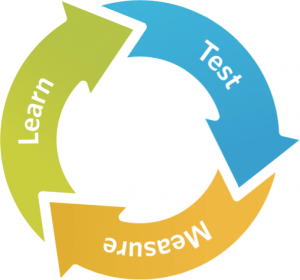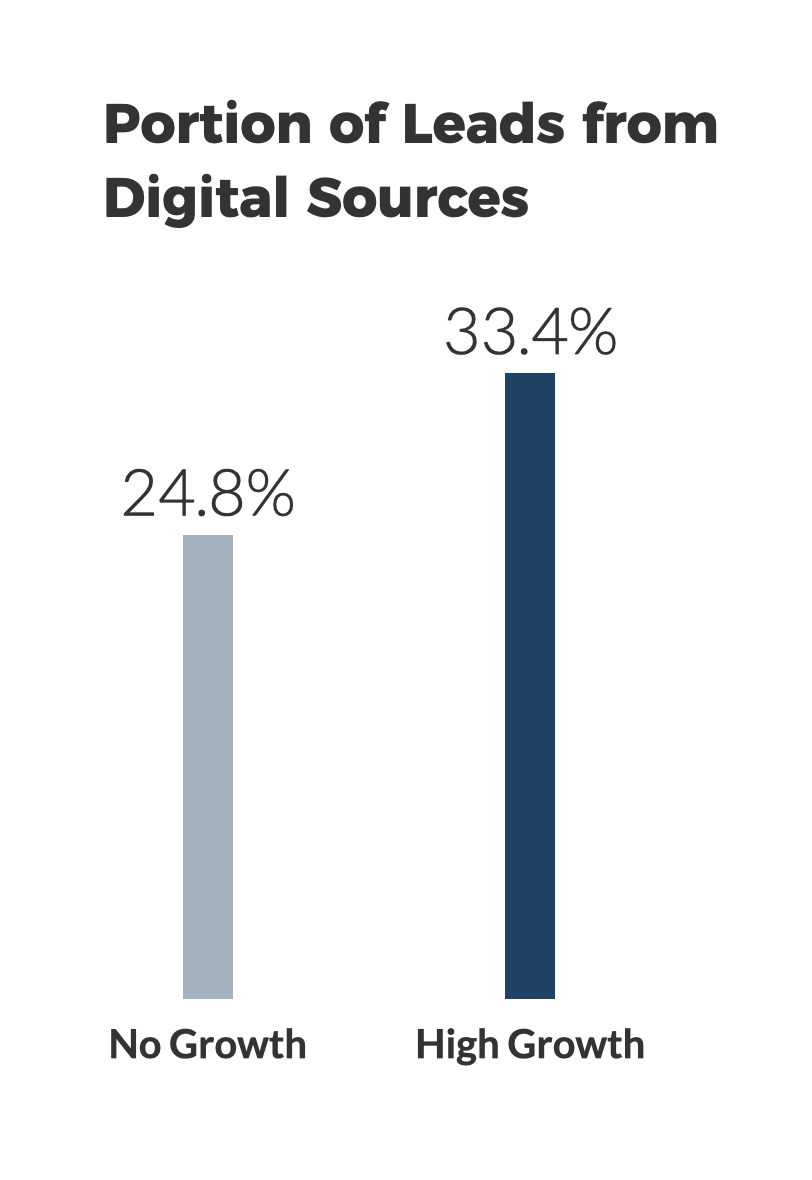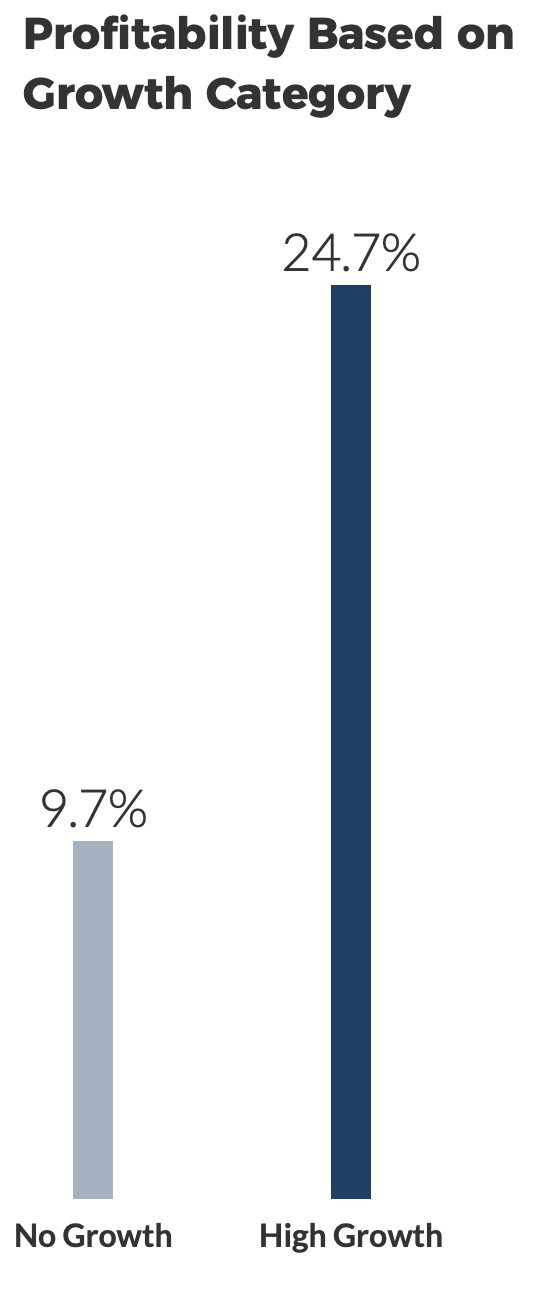Today’s budgets for any kind of expenditure are carefully allocated and critically examined, with pressure to realize a strong return on investment for every penny spent. And in the hallways of professional services, where many firms get by on reputation and referral business, marketing investment is often the last thing firms want to spend money on because they aren’t always convinced there will be a strong return. In this article, I’ll explore the reasons for measuring return, how to measure return, and strategies for realizing the return firms expect.
Hinge Research Institute’s 2023 High Growth Study serves as the foundation for this post, as it reveals what high-growth firms are doing to maximize their return on marketing investment both in dollars and effort. For context, we define a high-growth firm as one with a compound annual growth rate of 20% or greater over a three-year period.
Why Measure Return?
Few would argue with the virtues of holding investments in time, money, and people accountable for desired results. Beyond pure accountability however, stakeholders really must have a consistent handle on whether their marketing techniques are aligned with twists and turns in the external environment.
First, buyers are changing. Today’s prospective clients are more informed and expect to easily find what they want when they want it. They demand that services are delivered with consistency, transparency, and value at every turn. As for their relationship with their provider, they require personalization, responsiveness, and accountability. Consistent tracking of marketing investments and their associated return will signal to marketing and leadership teams how closely aligned their strategies are with the clients they want to be building their pipeline around in the coming years.
Second, the marketplace itself is changing. New competitors are crowding the services landscape and in some instances beating out incumbents with newer, faster, more relevant expertise. And while merger and acquisition activity may have tempered in some verticals, the purchasing, blending, and carving up of firms across professional services has transformed the way firms go to market. Finally, technology continues to erode geographic and other barriers that once figured so prominently in the buyer selection process.
Each of these shifts and changes means that the effectiveness of specific marketing strategies and tactics will fluctuate.
3 Guiding Principles for Measuring your Return
Nothing’s more frustrating than to see dollars spent on failed efforts. The question becomes why do so many marketing investments fail to deliver a solid return in the first place? In truth, there could be multiple answers, but one of the most common reasons marketing investments fail to live up to their expectations is that firms have no measurement of their performance. In fact our research shows nearly 1 in 4 professional services firms don’t do any kind of tracking or reporting on business development and marketing metrics.
How can this be?
A common challenge is understanding which metrics to track in the first place, and then figuring out how to report on them in a way that resonates with leadership who may not be in the trenches of marketing (and therefore won’t get too excited about metrics like growth in social media followers). Below I offer three guiding principles to help your measuring stay on track.
- The first task in figuring out what to track and how to measure is to consider the following:
- Select metrics that will continuously be available
- Select metrics that have a low component of judgment (objective)
- Prioritize metrics that will be accepted as relevant to leadership and other stakeholders who have a say in budget allocation
- Select metrics that are easy to monitor
- Next, consider the categories of metrics you’ll be monitoring.
- Impact metrics—These are the metrics that every stakeholder is looking for. What’s happening to your win rate? Monthly revenue? This category of metrics can also include raw (not yet qualified) leads or inquiries, “sales-ready” opportunities and actual proposals submitted. Your firm may describe these stages differently. It does not matter how you define your lead stages as long as you are consistent and capture the full new-business cycle. All told, this category of metrics will help you keep a pulse on how your marketing investment is (or isn’t) contributing to the bottom line.
- Visibility metrics —Beyond impact metrics, you’ll want to have a consistent gauge on how visible you are to your target audience. Without adequate visibility, you’ll have a tough time growing your pipeline beyond referrals and repeat business from existing clients. Common visibility metrics include total website traffic (web traffic rises with increased visibility), social media traffic and attendance at events.
- Expertise metrics — Buyers of professional services are, in the end, buying expertise, and it’s therefore important that firms have strong and consistent gauge on the extent to which their audience is exposed to their thought leadership content (i.e., are you successfully demonstrating your expertise?). Common expertise metrics include blog views, downloads of your premium content, guest posts, webinar attendees and frequency of getting tapped as a speaker at premium speaking events.
 Finally, firms should adhere to a model in which they continually test each technique, measure how it’s performing, learn from what works, and then factor those lessons into the next round of marketing decisions. Unless firms build discipline around this way of operating, there is simply zero way of knowing whether something is working, needs course correcting, or should be abandoned entirely. This figure illustrates this virtuous cycle of marketing, and it’s one that we at Hinge subscribe to religiously.
Finally, firms should adhere to a model in which they continually test each technique, measure how it’s performing, learn from what works, and then factor those lessons into the next round of marketing decisions. Unless firms build discipline around this way of operating, there is simply zero way of knowing whether something is working, needs course correcting, or should be abandoned entirely. This figure illustrates this virtuous cycle of marketing, and it’s one that we at Hinge subscribe to religiously.
3 Strategies for Achieving – and Understanding – Results
Now that the case has been made for why and how to measure the return on your marketing investment, let’s get into top strategies for ensuring you actually see that return – measuring aside! Back to the point made at the opening of this article, our 2023 High Growth Study serves as the foundation for these strategies, as it reveals three specific strategies high-growth firms are regularly incorporating into their business practices in order to maximize their return on marketing investment both in dollars and effort.
1. Conduct Research Regularly
There is a saying, “You don’t know what you don’t know.” So it makes sense that firms conducting regular research to better understand their clients’ evolving needs and the current state of their client’s market are able to make more informed strategic marketing decisions. Research provides the insight to connect with their clients’ and prospects’ key issues and evolving concerns and inform marketing strategies that yield a greater return on marketing investment. And, high-growth firms use systematic research to help their teams be responsive to the marketplace uncertainty discussed above. When they do research, they are more likely than their slower growing peers to conduct it frequently, often on a quarterly basis.

Research is not a one-and-done activity. We cannot overemphasize the importance of conducting research at least annually to keep your finger on the pulse of the marketplace. Your clients’ priorities and needs change over time, economic and political events may have significant impacts on business, and competition is ever-present and ever changing.
Not all research is the same. There are different methodologies and ways to structure research in order to achieve specific goals. A firm going through a merger that will result in a rebrand is interested in learning different things than a firm with a client base that has been affected by new regulations, so it’s important that each research initiative be structured to provide the insight and understanding you seek.
2. Allocate Resources Appropriately
When you set out to accomplish something, it’s important that you position yourself for success. At the outset, consider what it will take to get you where you want to go and then dedicate the necessary resources to achieve your goal—the people, time, dollars, etc. that are required to garner the desired results and return on marketing investment.

We liken it to building a factory. You don’t expect a factory to start producing a product and revenue without first making an investment in the plant, machinery and people (brainpower) needed to successfully produce results. This doesn’t mean that you have to have an exorbitant marketing budget. In fact we’ve found that high-growth firms actually spend less than average on marketing than their average or no-growth peers. And high-growth firms typically allocate less effort to traditional marketing techniques, which are often costly, and invest more effort in digital marketing. So it’s not a matter of investing more in marketing. Success comes from knowing where to invest your limited resources.
3. Track Results
Once you’ve determined, through your research, which tactics and channels to invest in, you must continually track results and recalibrate to optimize your marketing program and gain the most return on marketing investment. No-growth firms tend to focus on bottom-line metrics such as the number of new clients acquired. In contrast, high-growth firms track a wider group of variables spanning the entire marketing pipeline, including brand awareness, website traffic, social media engagement, lead generation and conversion rate. By tracking the full marketing cycle you can pinpoint exactly where in the pipeline you are succeeding and where there is room to improve.
Bottom Line:
High-growth firms not only grow faster but they are 2.5 times more profitable than their no-growth peers.

They conduct research on a regular basis to stay informed about the marketplace, their clients needs and their own performance. They use research findings to establish strategies and allocate budget and effort to techniques that provide maximum return on marketing investment. And high-growth firms continually track multiple metrics throughout their pipeline and adjust as needed to stay at the forefront of their market. If your firm is not already a high-growth performer, there’s no time to waste. Start implementing these strategies today.
How Hinge Can Help
Hinge is a global leader in helping professional services firms grow faster and become more profitable. Our research-based strategies are designed to be implemented. In fact, our groundbreaking Visible Firm® program combines strategy, implementation, training and more.
Additional Resources
- Discover what today’s most successful professional services firms are doing right in the research summary 2023 High Growth Study.
- For more hands-on help on becoming the next Visible Firm®, register for our Visible Firm® course through Hinge University.
- Find out more on becoming a sought-after expert in your industry by downloading a free copy of The Visible Expert℠ book.

